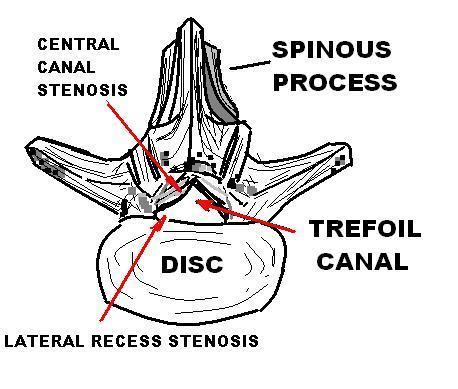ICD-10 M48.0 MedlinePlus 000441 | DiseasesDB 31116 | |
 | ||
Specialty Orthopedics, neurosurgery | ||
Spinal stenosis is an abnormal narrowing (stenosis) of the spinal canal that may occur in any of the regions of the spine. This narrowing causes a restriction to the spinal canal, resulting in a neurological deficit. Symptoms include pain, numbness, paraesthesia, and loss of motor control. The location of the stenosis determines which area of the body is affected. With spinal stenosis, the spinal canal is narrowed at the vertebral canal, which is a foramen between the vertebrae where the spinal cord (in the cervical or thoracic spine) or nerve roots (in the lumbar spine) pass through. There are several types of spinal stenosis, with lumbar stenosis and cervical stenosis being the most frequent. While lumbar spinal stenosis is more common, cervical spinal stenosis is more dangerous because it involves compression of the spinal cord whereas the lumbar spinal stenosis involves compression of the cauda equina.
Contents
Common
Neurological disorders
Causes
Aging: All the factors below may cause the spaces in the spine to narrow,
Arthritis: Two types,
Heredity:
Instability of the spine, or spondylolisthesis:
Trauma:
Tumors of the spine:
Types
The most common forms are cervical spinal stenosis, which are at the level of the neck, and lumbar spinal stenosis, at the level of the lower back. Thoracic spinal stenosis, at the level of the mid-back, is much less common.
In lumbar stenosis, the spinal nerve roots in the lower back are compressed which can lead to symptoms of sciatica (tingling, weakness, or numbness that radiates from the low back and into the buttocks and legs).
Cervical spinal stenosis can be far more dangerous by compressing the spinal cord. Cervical canal stenosis may lead to myelopathy, a serious conditions causing symptoms including major body weakness and paralysis. Such severe spinal stenosis symptoms are virtually absent in lumbar stenosis, however, as the spinal cord terminates at the top end of the adult lumbar spine, with only nerve roots (cauda equina) continuing further down. Cervical spinal stenosis is a condition involving narrowing of the spinal canal at the level of the neck. It is frequently due to chronic degeneration, but may also be congenital or traumatic. Treatment frequently is surgical.
Diagnosis
The diagnosis of spinal stenosis involves a complete evaluation of the spine. The process usually begins with a medical history and physical examination. X-ray and MRI scans are typically used to determine the extent and location of the nerve compression.
Medical history
The medical history is the most important aspect of the examination as it will tell the physician about subjective symptoms, possible causes for spinal stenosis, and other possible causes of back pain.
Physical examination
The physical examination of a patient with spinal stenosis will give the physician information about exactly where nerve compression is occurring. Some important factors that should be investigated are any areas of sensory abnormalities, numbness, irregular reflexes, and any muscular weakness.
MRI
The MRI has become the most frequently used study to diagnose spinal stenosis. The MRI uses electromagnetic signals to produce images of the spine. MRIs are helpful because they show more structures, including nerves, muscles, and ligaments, than seen on x-rays or CT scans. MRIs are helpful at showing exactly what is causing spinal nerve compression.
CT myelogram
A spinal tap is performed in the low back with dye injected into the spinal fluid. X-Rays are performed followed by a CT scan of the spine to help see narrowing of the spinal canal. This is a very effective study in cases of lateral recess stenosis. It is also necessary for patients in which MRI is contraindicated, such as those with implanted pacemakers.
Red flags
Treatments
Treatment options are either surgical or non-surgical. Overall evidence is inconclusive whether non-surgical or surgical treatment is the better for lumbar spinal stenosis.
Non-surgical treatments
The effectiveness of non surgical treatments is unclear as they have not been well studied.
Surgery
Lumbar decompressive laminectomy: This involves removing the roof of bone overlying the spinal canal and thickened ligaments in order to decompress the nerves and sac of nerves. 70-90% of people have good results.
